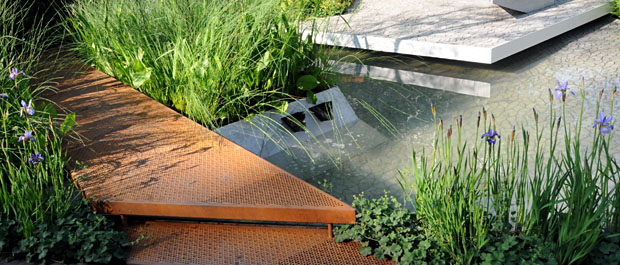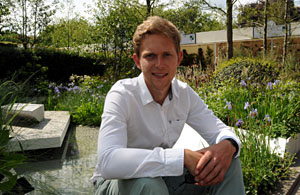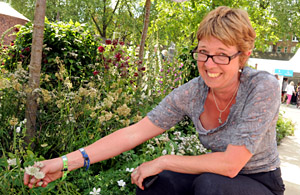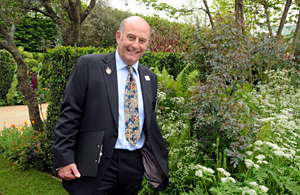Corfe Castle at sunrise

The RHS Chelsea Flower show in May is the highlight of the horticultural year and arguably the most important flower show in the world.
This year, Dorset again showcased the best of its gardening talent.

Former Lyme Regis student Hugo Bugg (27) became the youngest person ever to win a gold medal. An ex pupil of Woodroffe School, he created the RBC Waterscape Garden which highlighted global water issues and demonstrated practical, year-round water management solutions for home gardeners, showing how they can manage storm water in their own gardens.
The garden included innovative and sustainable concrete applications, showcasing a new moulding procedure resulting in dramatic and creative surfaces.
Blues, lime-greens and yellows were the predominant colours in the planting scheme including Iris bullyana, Iris robustra ‘Gerald Darby’, Euphorbia ‘Whistleberry Garnet’ and Geum ‘Lemondrops’. Plants had different roles in the garden’s filtration, rain garden, and retention pools, with unusual combinations and contrasts including Juncus inflexus, Lysimachia atropurpurea ‘Beaujolais’ and Amsonia tabernaemontana.
He worked with plants adviser Dave Aplin from Maiden Newton to create his stunning garden.

Christchurch garden designer Helen Elks-Smith designed the City of London Corporation Oak Processionary Moth Garden – a garden which draws the public’s attention to the dangers of the Oak Processionary Moth (OPM) and encourage public vigilance in reporting suspected infestations to the Forestry Commission, which could help reduce the pest’s devastating effects.
A stand of oak trees wass shrouded in bespoke textiles, as metaphors for the cocoons spun around the chrysalis and the white silken wedding nests so distinctive of Oak Processionary Moth. The shrouds consist of bespoke printed textiles designed by award-winning textile designer Tori McLean. The textiles were wrapped around the ‘’threatened’ trees to create unique sculptural forms with an ethereal sensibility.
The hornbeam columns (Carpinus betulus) represented barriers and the planting flows beneath the trees and between the columns. White plants such as Digitalis purpurea albiflora and Geranium phaeum ‘Album’ combined to create a flow of planting that spilled through the gaps representing how pests and diseases take advantage of gaps in treatment of OPM or biosecurity.
The shrouds, as symbols of decay, reached across a divide to a group of healthy oak trees. The hornbeam columns formed barriers. How the planting flowed through the gaps between these barriers represented how pests and diseases will take advantage of gaps in treatment of OPM or biosecurity.
The moth has an established population in the UK. Helen says why they can be a problem: “The caterpillars hairs may cause skin irritation and asthma. The trees are often defoliated and although they generally recover in the subsequent season there is evidence that it is a contributing factor to an overall decline in the health of the tree.”
“Oak trees are an essential part of our landscape. They provide a habitat for more organisms, especially insects, than any other tree. Because of its large size and longevity, it plays a unique role in forest ecosystems and many species have adapted to live with it. I think I would count humans in that category. Life for me is certainly enriched by the oak trees in the landscape.”
Although the moth does not currently breed in Dorset, it may do in the future.
The garden was awarded a Silver Flora medal.
The Cloudy Bay Sensations Garden by Gavin McWilliam and Andrew Wilson used Purbeck limestone from Swanage-based Lovell Stone.
The garden was designed to reflect the tasting notes of the Cloudy Bay wines. Using this as the basic concept, planting and flower colours, perfumes and textures were used to visualise the sensations experienced when drinking the wine.
Flower colour wass used to create a splash of sensational shades across the garden. Deep blackberry notes contrasted with raspberry reds and softer pinks, drifting into frothy whites and pale gooseberry tones. Roses, irises and peonies create intense colour depth and perfumes, set against a simple palette of oak and hazel coppice, woodland grasses and sweet woodruff. Gooseberry, raspberry and redcurrant are dotted through the naturalistic planting. To the front of the garden the colour planting drifted into soft ornamental grasses and bulbs. A specimen medlar and a pomegranate created foreground interest.
Oak and charred oak were combined with limestone surfaces and sparkling water to complete the design as a garden of sensory delight. Tall oak panels created a sense of elegance and oak and hazel coppice with woodland fruit contrast the drama of the colour swathe that splashed across the garden.
Gavin McWilliam and Andrew Wilson were awarded a Silver-Gilt Flora.

It’s not just Fresh and Show Gardens that had Dorset connections. Neil Lucas from Knoll Gardens in Wimborne attended as chairman of a floral panel in the Great Pavillion. In previous years he has exhibited his top class collection of grasses, winning RHS Gold.
“Chelsea has the highest standards and I look for something with ‘wow’ factor,” he said.
There were also plenty of tradestands with exhibitors from the county including Plankbridge shepherds hut makers from Dorchester.
The RHS Chelsea Flower Show 2014 was on from Tuesday 20 – Saturday 24 May 2014
20 – 21 May RHS members only
22 – 24 May RHS members and non-members
Dorset connections at the RHS Chelsea Flower Show
Show Gardens
Cloudy Bay Sensations Garden
Sponsor: Cloudy Bay
Designer: Gavin McWilliam and Andrew Wilson
Site Number: MA3
Fresh Gardens
Helen Elks-Smith, Christchurch
Site Number: FR5
Tradestands
Plankbridge Ltd, Dorchester
Site Number: PLW1
Backdoorshoes, Christchurch
Site Number: EA61
Burgon & Ball Ltd, Poole
Site Number: CW1
The Wildlife Trusts, Poole
Site Number: EA59
Fantails, Swanage
Site Number: PW31
Felix Campania and Sons Ltd, Poole
Site Number: PW33